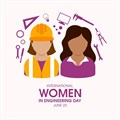Engineering gender equality: We have a strong foundation but cracks are showing

Why? Because firms with more women in leadership positions report higher shareholder ROI and productivity, greater innovation and better products, and higher employee retention and satisfaction.
We’re making strides. Policies are in place, business commitment is strong, and younger females are showing more interest in the industry.
From the outside, it appears everything is stacked in women’s favour. But look closer, and you’ll see the cracks.
The more things change, the more they stay the same
According to a recent report from the Engineering Council of South Africa (ECSA), less than a quarter of candidate engineers in South Africa are women. More worryingly, when it comes to professional engineers in South Africa, only 6% are women.
The issues in the engineering space are further symptomatic of other challenges in our society, especially when considering that only 13% of all graduates in South Africa — who leave tertiary institutions with qualifications in science, technology, engineering and mathematics (STEM) — are women.
Tackling these challenges requires a different approach, and I’ll highlight three ways in which we can start to think differently about this.
Accepting that emotional tax is a real thing
Because there is so much pressure on organisations to be diverse, we’re seeing underlying attitudes express themselves in subtle discrimination.
From a Black woman being promoted to senior management but then not given stretch work, to a male colleague condescendingly explaining something to a female colleague as if she can’t possibly understand what he is talking about. It results in a feeling that you always need to have your guard up – you expect underhanded comments and don’t feel like you’re taken seriously; you dress or act a certain way to ‘fit in’; you feel unsafe in certain situations; and you feel pressure to work extra hard to prove yourself.
And it’s exhausting functioning in a permanent state of fight or flight.
The solution: Workforces need to be more sensitive to the intentional and unintentional behaviours that increase emotional tax on women. Creating awareness through a once-off PowerPoint session won’t cut it. Respect, inclusion, and moral and ethical behaviours need to be entrenched into a business’s culture and need to be driven by the C-Suite.
Recognising the invisible mental workload
As if the stress of emotional tax wasn’t enough, women also carry an invisible mental workload that few men have to deal with: running a household. Cooking dinner, caring for a sick child, and cleaning are just a few of the domestic tasks that quickly add up to a ‘second job’ for many working women.
Research has shown that in heterosexual couples where both partners work, household management falls disproportionately on women. This has also been identified as one of the factors that stop women from putting themselves forward for leadership positions.
This is an aspect of our society that was particularly exposed during the Covid-19 pandemic where women faced even higher levels of strain. For women, there is no downtime.
The solution: The bottom line is that women need support. By offering more flexibility to both men and women (and not raising eyebrows when they take advantage of those benefits), men can shoulder some of the domestic responsibility and women can plan their work and personal lives better so that both their families and their employers get the best of them. By creating internal networking groups, women can find and give support to others.
Realising that our work here is never done
There’s a phenomenon called ‘moral licensing’ that sees people or businesses initially displaying moral behaviour but quickly slipping back into old – or worse – habits. For example, a business might hire and promote women and give them equal benefits at work but does little to discourage sexist or racist comments or behaviour.
We need to guard against paying lip service to gender diversity and making short-term changes while not fully committing to dealing with discrimination, stereotyping, and bias in the workplace. That’s window dressing.
Malcolm Gladwell explains this perfectly in his podcast, ‘The Lady Vanishes’. He suggests that old habits die hard and provides examples throughout history of how doors are opened to allow women to rise up the ranks of male-dominated industries but are quickly slammed shut and things revert to the way they were.
This is not good enough. It’s not about making room for women in engineering. We already fit here – and we fit well. We need to overhaul deeply entrenched beliefs and opinions that keep coming back to haunt us and to re-establish the patriarchy.
We’re not asking to be treated differently or with kid gloves. We want to be heard, respected, and acknowledged for the professionals that we are and for the dynamism, creativity, and empathy that we bring to the workforce. These are the personality traits that a ‘hard’ industry like engineering so desperately needs. Because it’s not just men who benefit from the work of engineers, it’s also our mothers, daughters, and sisters. Shouldn’t we also have a say in what that future looks like?



